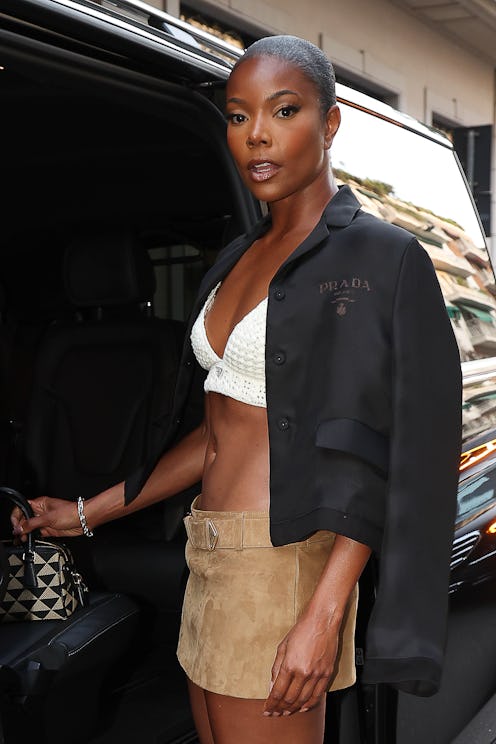Beauty
Patchworking Needs To Be Your New Go-To Technique For Glowing Skin
Two celebrity MUAs share their top tips.

If we have learnt anything from Hailey Bieber’s glazed donut skin, Rosie Huntington-Whiteley’s “lit-from-within” complexion, or Yarah Shahidi’s glistening cheekbones, it is that glowy skin is here to stay. And while a radiant glow during the summer months hardly seems groundbreaking (the beauty equivalent of that seminal The Devil Wears Prada “florals for spring” quip, if you will) there is a make-up artist-approved technique which can elevate your look: patchworking.
The patchworking technique which involves applying different skincare products and base products – tinted moisturiser, foundation, concealer, powder – to different areas of the face then melding into a seamless, glowing finish. See Spring/Summer 2022, where David Koma’s models went down the catwalk wearing light-reflecting face gloss, while at Roberto Cavalli luminous complexions were the order of the day.
“I’ve used patchworking on all of my clients since the beginning of my career,” says Lisa Eldridge, the celebrity make-up artist behind the luminous skin of Bella Hadid’s Versace campaign. Eldridge has long favoured a bespoke blend of products, rather than relying on uniform finishes to blanket the face as believes it is very “intuitive” and results in "your most naturally perfected complexion yet.” Make-up artist Esther Edeme shares the approach, too. Edeme recently used the technique on Gabrielle Union during Milan Fashion Week to create a polished look she describes as “giving life, movement, and youthfulness.” Intrigued on how to do it? Read on to find out more about patchworking.
What Is Patchwork Skin?
Patchwork skin is a make-up artist-inspired technique where different skincare and base products of varying textures, formulas, and finishes are carefully chosen and strategically applied to different areas of the face, and seamlessly blended into one another. Eldridge describes patchworking as “sewing together a patchwork quilt of products but the end result is that each piece blends into the next square, so everything looks like it’s supposed to be there.”
Does Patchworking Suit Every Skin Type?
In short, yes. “Patchworking is perfect for every skin type because it’s about the thoughtful placement of products designed to work with your complexion, instead of against it,” says Edeme. ”If you have very dry skin that tends to absorb glow then applying hydrating, illuminating skincare and foundations with cushiony textures to areas lacking natural oils will complement your complexion more than a one-size-fits-all moisturiser and base which may deplete natural oils and steal your natural luminosity."
“Skin has areas that are dryer than others and oilier than others so ‘patchworking’ means you get every need catered for,” adds Eldridge.
How To Patchwork
The experts suggest assessing what your complexion needs and starting with the application of a hydrating serum to leave skin looking and feeling refreshed all over. Both make-up artists suggest then starting with the centre of the face. Eldridge recommends a gel cream, applied to the middle of the forehead, the bridge of the nose, across the cheeks, and down to the chin. Edeme explains that the concentration of pores in this particular area “means it can appear overly shiny, even on skin prone to dryness.” Her solution? “Applying lightweight, mattifying formulas to this area keeps your glow under control.”
On especially dry complexions, Eldridge massages a nourishing and brightening serum, like Goldfaden MD Radiance Repair Serum, around the outside of the face, corners of the nose, and down the neck. Edeme leans towards luxe, super creamy moisturisers like Charlotte Tilbury Charlotte’s Magic Cream.
Next, use a liquid highlighter and a blending brush to bring forward areas of the face where light hits naturally. Eldridge swipes highlighter across cheekbones, dabs above the upper lip, glides down the centre of the nose, and dots on the inner corner of the eyes before melting into skin with light strokes of a blending brush to create what she describes as “an undercoat”.
Then, depending on the coverage you are after, the pros recommend mixing light layers of tinted moisturiser or foundation around different areas of the face. Playing with textures and finishes can further complement different areas of the face.
Eldridge melts the different layers together using the warmth of her fingers, focusing it “anywhere than needs evening out” and “neutralising redness” at the same time. She follows that up with brightening concealer underneath the eyes, and brings everything together without edges and covers blemishes with camouflaging concealer.
Edeme prefers to work with a variety of foundations, colour matching the multiple tones within skin, especially when working on darker complexions such as Leomie Anderson’s. She recommends using a lighter shade on the centre of the face, a medium shade from the jaw down to the chest, and a darker colour on outer areas for definition. Instead of blowing your beauty budget on new shades and formulas, diving into your make-up bag and bathroom cabinet may give a second life to that slightly warmer foundation you bought towards the end of summer or the nourishing balm that’s an S.O.S during winter months.
Eldridge brings it all together by blending with a small foundation brush and sets with loose powder, strictly focusing on areas prone to shine, such as the side of the nose and center of the forehead. While it may seem like the process requires more steps and products, cherry-picking some of the simpler elements of patchworking and adopting a tailored approach to your skincare application could transform the finish and staying power of your base.